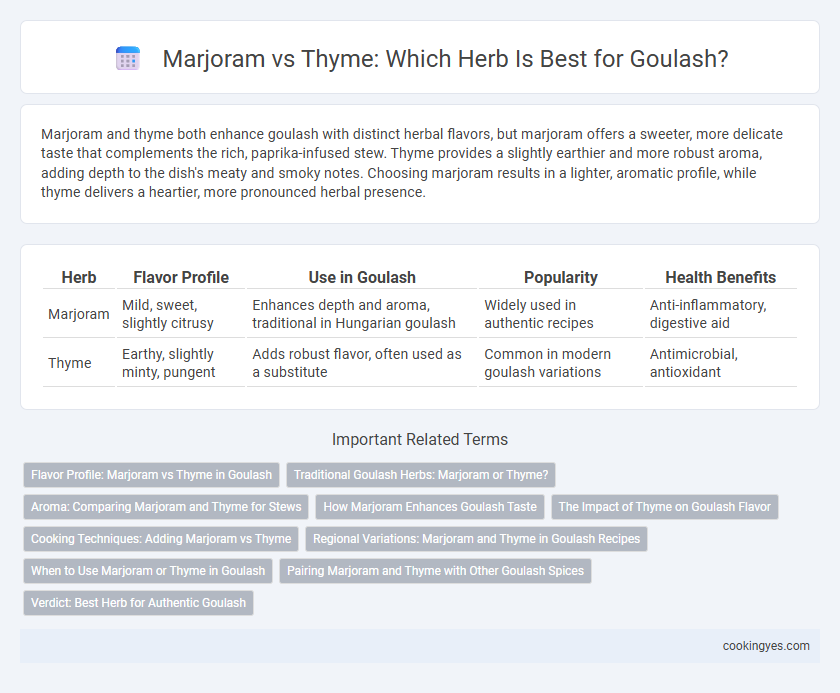Marjoram and thyme both enhance goulash with distinct herbal flavors, but marjoram offers a sweeter, more delicate taste that complements the rich, paprika-infused stew. Thyme provides a slightly earthier and more robust aroma, adding depth to the dish's meaty and smoky notes. Choosing marjoram results in a lighter, aromatic profile, while thyme delivers a heartier, more pronounced herbal presence.
Table of Comparison
| Herb | Flavor Profile | Use in Goulash | Popularity | Health Benefits |
|---|---|---|---|---|
| Marjoram | Mild, sweet, slightly citrusy | Enhances depth and aroma, traditional in Hungarian goulash | Widely used in authentic recipes | Anti-inflammatory, digestive aid |
| Thyme | Earthy, slightly minty, pungent | Adds robust flavor, often used as a substitute | Common in modern goulash variations | Antimicrobial, antioxidant |
Flavor Profile: Marjoram vs Thyme in Goulash
Marjoram offers a sweet, citrusy flavor with subtle floral notes that enhance the rich, hearty taste of goulash without overpowering it. Thyme delivers a more earthy, slightly minty aroma with hints of lemon and pepper, adding depth and complexity to the dish's savory profile. Choosing marjoram brings a brighter, warmer accent, while thyme contributes a robust, grounded herbal undertone to traditional goulash recipes.
Traditional Goulash Herbs: Marjoram or Thyme?
Traditional goulash recipes often highlight marjoram as the preferred herb due to its sweet, aromatic flavor that complements the rich, paprika-infused stew. Thyme, with its earthy and slightly minty notes, can be used as an alternative but may alter the classic taste profile of Hungarian goulash. Using marjoram preserves the authentic balance of spices, making it a staple herb in traditional preparations.
Aroma: Comparing Marjoram and Thyme for Stews
Marjoram offers a sweet, citrusy aroma with subtle floral notes that enhances the depth of goulash without overpowering other ingredients. Thyme provides a robust, earthy scent with slightly minty undertones, lending a savory richness to stews. Choosing marjoram emphasizes a lighter, aromatic profile, while thyme contributes a more intense, herbaceous fragrance ideal for hearty goulash.
How Marjoram Enhances Goulash Taste
Marjoram enhances goulash by adding a subtle, sweet, and citrusy aroma that complements the rich, smoky paprika and tender beef. Unlike thyme, which imparts a more earthy and slightly bitter flavor, marjoram brightens the dish, balancing the stew's deep, savory notes. This herb's delicate fragrance elevates the traditional Hungarian recipe, resulting in a more complex and authentic taste profile.
The Impact of Thyme on Goulash Flavor
Thyme imparts a robust, earthy aroma to goulash, enhancing its rich, savory depth with subtle notes of mint and lemon that complement the dish's paprika base. This herb's slightly bitter undertone balances the sweetness of onions and tomatoes, creating a more complex flavor profile compared to marjoram's milder, sweeter fragrance. Incorporating thyme elevates goulash by adding warmth and aromatic intensity, making it a preferred choice for traditional recipes seeking bold, layered taste.
Cooking Techniques: Adding Marjoram vs Thyme
Marjoram releases a sweet, citrusy aroma when added towards the end of cooking goulash, preserving its delicate flavor and enhancing the dish's overall complexity. Thyme, with its earthy and slightly minty tone, benefits from longer cooking times, allowing its robust profile to infuse deeply into the stew. For optimal layering, incorporate thyme early in the simmering process and sprinkle marjoram just before serving to balance intensity and freshness.
Regional Variations: Marjoram and Thyme in Goulash Recipes
Marjoram dominates traditional Hungarian goulash recipes, imparting a sweet, aromatic flavor that complements the paprika and beef. Thyme appears more frequently in Central European variations, offering a slightly woodier, earthier note that balances richer, heartier broths. Regional preferences highlight marjoram's association with authentic Hungarian cuisine, while thyme adapts well to German and Austrian goulash styles.
When to Use Marjoram or Thyme in Goulash
Marjoram is ideal for goulash when a sweet, floral herb flavor is desired, especially in traditional Hungarian recipes that emphasize its subtle aroma. Thyme works best in goulash recipes requiring a more earthy and robust herb profile, complementing beef or game meats with its slightly minty and peppery notes. Use marjoram during the simmering stage for delicate infusion, while thyme can be added earlier to release its stronger flavors through longer cooking.
Pairing Marjoram and Thyme with Other Goulash Spices
Marjoram pairs exceptionally well with paprika, caraway seeds, and garlic in goulash, enhancing its warm, earthy flavors with a subtle citrus note. Thyme complements bay leaves, black pepper, and onions, adding depth and a slightly minty aroma that balances rich meats and tomatoes. Combining marjoram and thyme creates a harmonious blend that intensifies the traditional spice profile, elevating the complexity and authenticity of goulash.
Verdict: Best Herb for Authentic Goulash
Marjoram is widely considered the best herb for authentic goulash due to its sweet, aromatic flavor that complements the rich paprika and beef base traditionally used in the dish. Thyme, while common in various stews, can overpower goulash's delicate balance with its more pungent, earthy notes. Authentic Hungarian recipes typically highlight marjoram to achieve the classic goulash taste revered in traditional cuisine.
Marjoram vs thyme for goulash herbs Infographic

 cookingyes.com
cookingyes.com